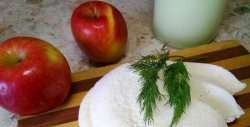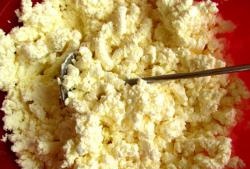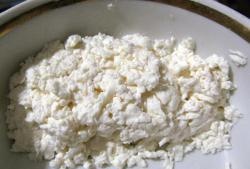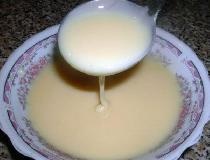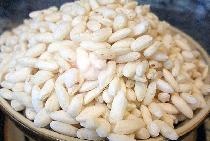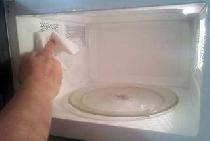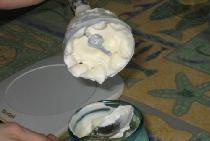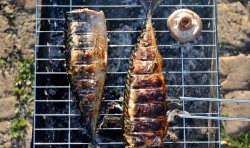Homemade cheese cheese
Homemade cheese, the process of which is completely in the hands of the housewife from scratch, is sometimes much better than cheese from the store with its not entirely healthy additives and “secrets” of production. You will be surprised, but you can prepare many varieties at home: mascarpone, suluguni, feta cheese, etc. In this master class we will talk about feta cheese, since this cheese requires only two ingredients: milk and cheese enzyme.
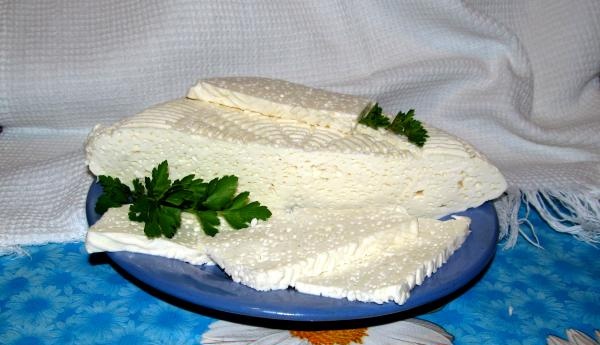
To prepare cheese at home you will need:
homemade milk;
cheese enzyme;
water thermometer;
a large saucepan or any other container for the stove;
colander;
gauze or thin white cloth;
salt.
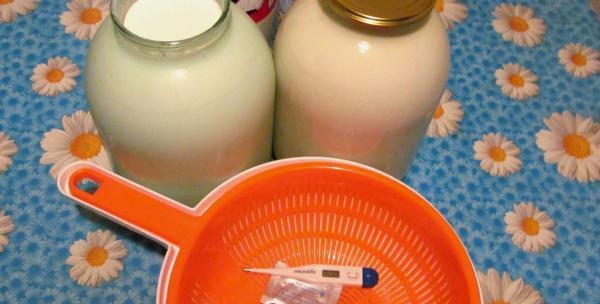
Milk has a big influence on the final result - it must be homemade, and the fattier it is, the more cheese you will get in the end. From 10 liters of homemade milk of medium fat content you can make about 1.5 kg of cheese.
Important: if you do not have your own milk, you should buy it only from trusted sellers who monitor the cleanliness and health of their animals. This is due to the fact that the milk in this recipe does not undergo proper heat treatment.
So, pour the milk into a saucepan and then put it on low heat. Don’t go far, as it will heat up quickly (to the desired temperature of 35 degrees).

At this time, you can start breeding Meito cheese enzyme, which can be purchased at any specialized online store. A packet of enzyme is designed for 100 liters of milk, so it must first be divided into 10 parts. Dilute one of the parts with 100 ml of water at room temperature (not hot).
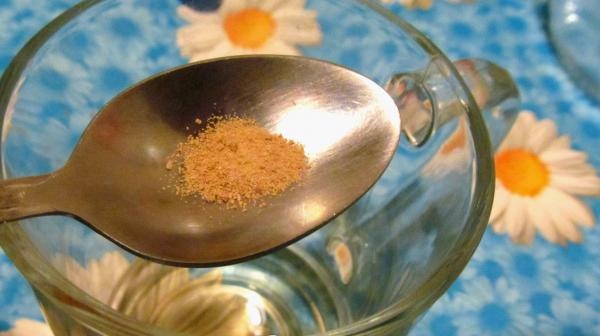
While you are working with the enzyme, the milk will become lukewarm. This is enough, but just in case, check its temperature. If you don't have a water thermometer on hand, you can use a household electronic equivalent, although it must be 100% waterproof. The temperature of warm milk in this recipe does not exceed 35 degrees, so a regular electronic thermometer will cope with the task successfully.
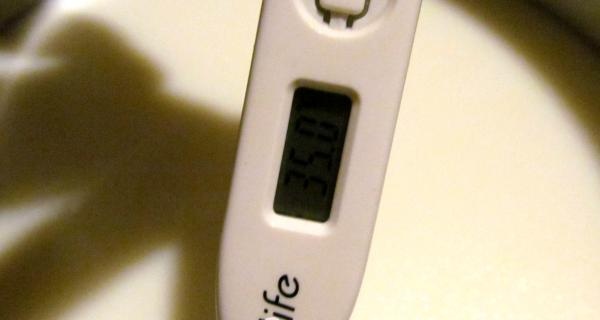
Next, pour the prepared glass with the enzyme into a saucepan removed from the stove, then stir the milk thoroughly. At this stage, your participation in the preparation ends for now, since the milk must be left for 20-30 minutes.
Half an hour will pass, and you can return to the future cheese. During this time, the milk will turn into a gelatinous substance, which must be cut with a knife (right in the pan) into small pieces, and then left for another 15 minutes.
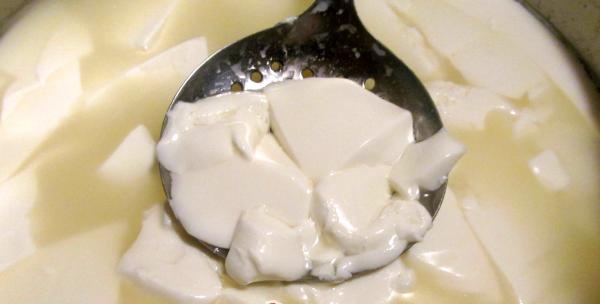
The next step is to remove the whey, for which you carefully transfer the mass into a colander with gauze (you need to place some container under the colander to collect the whey). In the future, it can be used to make pancakes, bread, and just drink it. Also, to speed up the process, it would be nice to do a little bending using a regular jar of water.
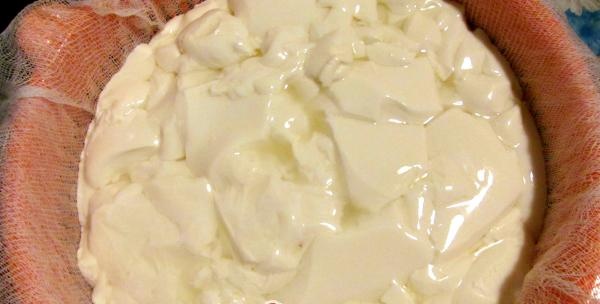
After an hour, the cheese must be carefully turned over so that the whey drains better.By this time, the mass becomes dense, a clear pattern from the colander appears on it, so you can already remove the gauze.
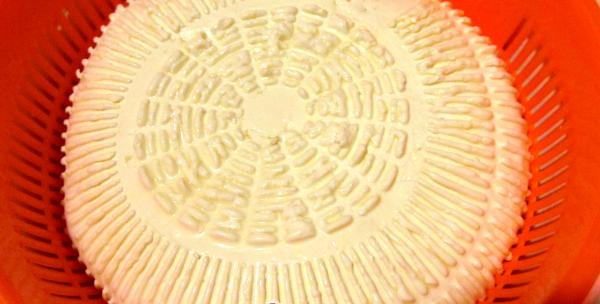
After another hour, the cheese is filled with brine (whey with salt slightly higher than your taste). There is no need to keep it in brine for a long time - 15-20 minutes is enough.
Please note: if you like your cheese to have holes in it, leave it out of the refrigerator for a couple more hours.
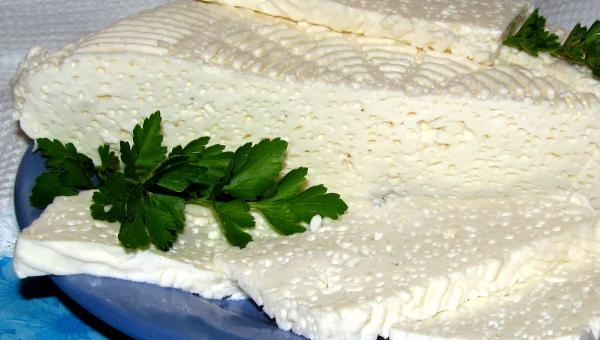
That's it, delicious homemade cheese is ready.

To prepare cheese at home you will need:
homemade milk;
cheese enzyme;
water thermometer;
a large saucepan or any other container for the stove;
colander;
gauze or thin white cloth;
salt.

Milk has a big influence on the final result - it must be homemade, and the fattier it is, the more cheese you will get in the end. From 10 liters of homemade milk of medium fat content you can make about 1.5 kg of cheese.
Important: if you do not have your own milk, you should buy it only from trusted sellers who monitor the cleanliness and health of their animals. This is due to the fact that the milk in this recipe does not undergo proper heat treatment.
So, pour the milk into a saucepan and then put it on low heat. Don’t go far, as it will heat up quickly (to the desired temperature of 35 degrees).

At this time, you can start breeding Meito cheese enzyme, which can be purchased at any specialized online store. A packet of enzyme is designed for 100 liters of milk, so it must first be divided into 10 parts. Dilute one of the parts with 100 ml of water at room temperature (not hot).

While you are working with the enzyme, the milk will become lukewarm. This is enough, but just in case, check its temperature. If you don't have a water thermometer on hand, you can use a household electronic equivalent, although it must be 100% waterproof. The temperature of warm milk in this recipe does not exceed 35 degrees, so a regular electronic thermometer will cope with the task successfully.

Next, pour the prepared glass with the enzyme into a saucepan removed from the stove, then stir the milk thoroughly. At this stage, your participation in the preparation ends for now, since the milk must be left for 20-30 minutes.
Half an hour will pass, and you can return to the future cheese. During this time, the milk will turn into a gelatinous substance, which must be cut with a knife (right in the pan) into small pieces, and then left for another 15 minutes.

The next step is to remove the whey, for which you carefully transfer the mass into a colander with gauze (you need to place some container under the colander to collect the whey). In the future, it can be used to make pancakes, bread, and just drink it. Also, to speed up the process, it would be nice to do a little bending using a regular jar of water.

After an hour, the cheese must be carefully turned over so that the whey drains better.By this time, the mass becomes dense, a clear pattern from the colander appears on it, so you can already remove the gauze.

After another hour, the cheese is filled with brine (whey with salt slightly higher than your taste). There is no need to keep it in brine for a long time - 15-20 minutes is enough.
Please note: if you like your cheese to have holes in it, leave it out of the refrigerator for a couple more hours.

That's it, delicious homemade cheese is ready.
Similar master classes
Particularly interesting
Comments (3)

